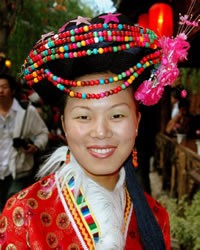Naxi in China

Photo Source:
Copyrighted © 2026
Lee Snider - Shutterstock All rights reserved. Used with permission |
Send Joshua Project a map of this people group.
|
| People Name: | Naxi |
| Country: | China |
| 10/40 Window: | Yes |
| Population: | 335,000 |
| World Population: | 335,000 |
| Primary Language: | Naxi |
| Primary Religion: | Ethnic Religions |
| Christian Adherents: | 0.80 % |
| Evangelicals: | 0.07 % |
| Scripture: | New Testament |
| Ministry Resources: | Yes |
| Jesus Film: | Yes |
| Audio Recordings: | Yes |
| People Cluster: | Tibeto-Burman, other |
| Affinity Bloc: | Tibetan-Himalayan Peoples |
| Progress Level: |
|
Introduction / History
Since migrating from Tibet, the Naxi have lived in Lijiang approximately 1,000 years. references in Naxi literature to Lake Manasarovar and Mt. Kailas, both in farwestern Tibet, confirm the Naxi's origins. By the time the Mongol hordes swept through Lijiang in 1253, it was already populated by 1,000 families. On 3 February 1996, a huge earthquake shook Lijiang and surrounding districts. Three hundred people died, 40,000 were injured, and 300,000 were made homeless.
The Naxi have been combined with several smaller groups to form one of China's official minorities. The Naxi trace their origins to an elephant-headed god named Tabu, who helped them hatch from magic eggs. The name Naxi means "respectable people."
One of the most distinctive aspects of Naxi culture is their ancient pictographic script. The Naxi developed the system of 1,500 pictographs more than 1,000 years ago, perhaps so they could record their religious laws before setting out to their new lands. Today some 20,000 Naxi manuscripts appear in museums and private collections in China and around the world. The pictographs were only read by the Dongbas - priests of the Dongba religion. In 1995 only three old men, aged 71, 76, and 86, could read the Naxi script. Naxi consists of three main dialects. A Naxi-English dictionary exists.
What Are Their Lives Like?
Naxi society is traditionally known for its matriarchal practices. For centuries, all property and assets were passed down through the woman's side of the family. Naxi men were only entitled to visit their azhu (walk-in friend) at night for sexual purposes, and to return at dawn to their mother's house. Matriarchal society started to subside in 1723 when Lijiang came under Chinese control. Naxi women protested their falling status by killing themselves. The annual "Sacrifice to Heaven" was last practiced in Lijiang in 1949. The favored way of dying was by taking poison. Today, matriarchal customs are seen more among the Mosuo farther to the north.
What Are Their Beliefs?
Although today many Naxi are nonreligious, in the 1940s there were more than 4,000 Naxi Dongba priests. Their religion was "characterized by a fascination with power and wonder-working, and belief in a multitude of gods and demons who are manipulated with magic."
The first missionaries to the Naxi arrived in 1912. By 1930 there were eight or nine baptized Naxi believers. In 1932 the Dutch Pentecostal Mission Society translated Scripture portions into Naxi, but these are now obsolete. In the early 1950s the Naxi church was destroyed by the communists. Today there are a small number of Naxi believers in Lijiang, and there are Naxi Catholics mixed in with Lisu and Tibetan congregations farther north. More than 1,000 Naxi are members of the Mentu Hui cult, founded by Ji Sanbao, who claims to be a Second Christ.
What Are Their Needs?
Like people everywhere, the Naxi people need to allow the loving savior to direct their lives. They need his forgiveness for sin.
Prayer Points
Pray for an awakening among Naxi Christians that will spread to non-believers.
Pray that the Naxi will be disenchanted with magic.
Pray a cult believing in a "second Christ" will become true followers of the true Christ.
Pray for signs and wonders to happen among them and for great breakthroughs with a rapid multiplication of disciples and house churches.